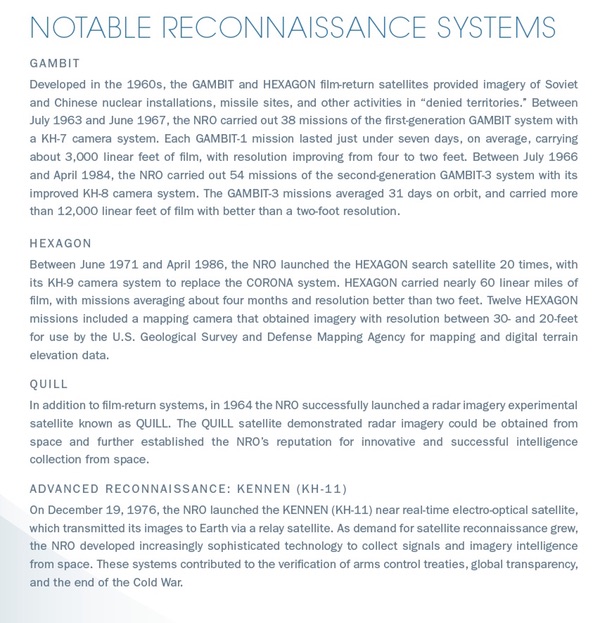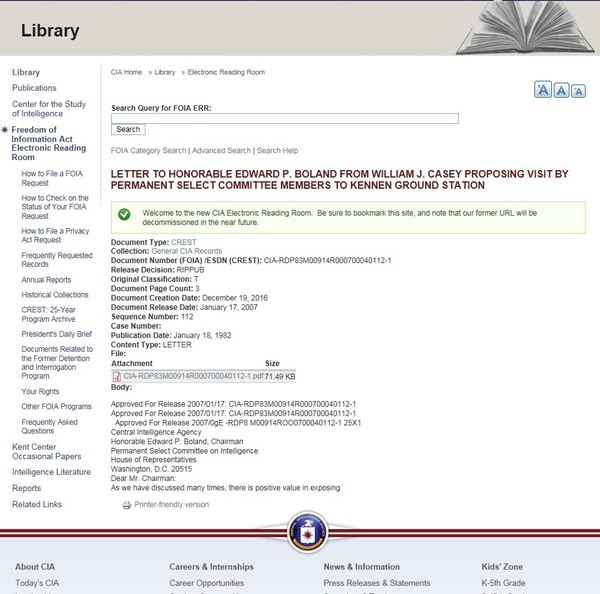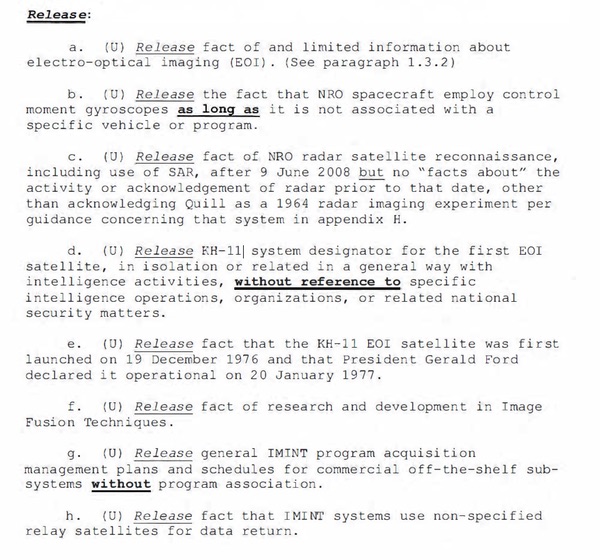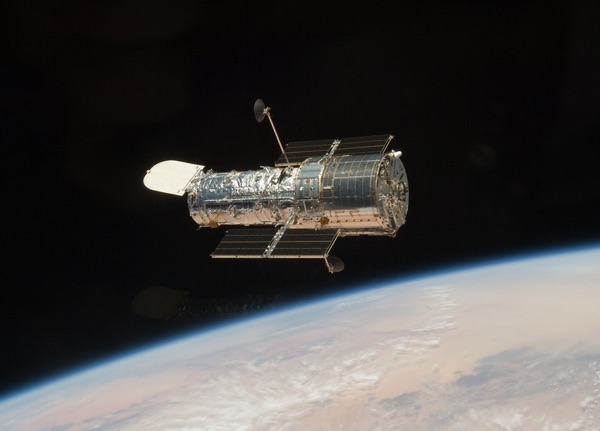Piecing the puzzle by piercing the veil: The declassification of KENNENby Joseph T. Page II
|
| Prior releases within the NRO guide mentioned only the launch date, first electro-optical satellite, and the designator “KH-11.” But not the BYEMAN codename. |
For those in the know, mention of this name in open press outside cleared facilities immediately gives way to the intelligence community’s poker face. “I have no idea what you are talking about,” or “I can neither confirm nor deny,” were two oft-heard phrases coming from the defense and intelligence establishments when asked by reporters or industry analysts about the KH-11 and its capabilities. In contrast, space aficionados probably didn’t blink at this release, since the name was leaked decades ago, and covered in William Burrow’s Deep Black.
However, release of the name now, after minor facts about the system were revealed (inside the 2012 NRO Review and Redaction Guide), are strong indications that something “big” is about to happen.
Researchers and students of tomorrow will not understand the meaning of this (presumed) declassification effort. They will blithely approach the topic with searches on Wikipedia or their favorite search engine. Future space historians won’t bat an eyelash when talking about EOI satellite capabilities. But space history junkies know the truth: this is huge, an acknowledgement of the first EOI reconnaissance satellite after the first and second-generation film-based systems (CORONA, GAMBIT, and HEXAGON).
Signs point to yes
Fellow space historian Dwayne Day pointed out the first release of the codename KENNEN was in the NRO brochure, of all places. The text states:
 Screenshot of the NRO Brochure stating the purpose of the KH-11, aka KENNEN. (credit: NRO) |
“ADVANCED RECONNAISSANCE: KENNEN (KH-11)
On December 19, 1976, the NRO launched the KENNEN (KH-11) near real-time electro-optical satellite, which transmitted its images to Earth via a relay satellite. As demand for satellite reconnaissance grew, the NRO developed increasingly sophisticated technology to collect signals and imagery intelligence from space. These systems contributed to the verification of arms control treaties, global transparency, and the end of the Cold War.”
Prior releases within the NRO guide mentioned only the launch date, first electro-optical satellite, and the designator “KH-11.” But not the BYEMAN codename.
CREST, now with 50 percent more FOIA!
Subsequent clues to KENNEN lay within the CIA’s Freedom of Information Act (FOIA) database called CREST (CIA REcords Search Tool). News articles in mid-January 2017 stated that over 12 million declassified documents were being placed online through CREST, with topics ranging from UFOs and psychic warfare to standard intelligence estimates. The word KENNEN would be included in the maelstrom of megabytes.
Since each of the NRO Alphabet Programs were controlled by a different government entity, and no comprehensive Air Force or Navy historical database exists, I thought it was worth a try to search for the keyword “KENNEN.” What I found floored me, for two reasons. First, search metadata found the word, but not inside the document text. Second, this was the first time that an NRO system was openly associated with having a ground station. Prior releases only mention the Satellite Operations Center at the Pentagon, and the Air Force Satellite Test Center in Sunnyvale, California.
 CREST search results for keyword “KENNEN”. (credit: CIA/CREST) |
The first search result was an obvious error, since it dealt with historian and policy-maker George Kennan; a misspelling of his last name brought it to the fore. The second search result was titled “LETTER TO HONORABLE EDWARD P. BOLAND FROM WILLIAM J. CASEY PROPOSING VISIT BY PERMANENT SELECT COMMITTEE MEMBERS TO KENNEN GROUND STATION.” When I saw that, I only had one thought: “Paydirt!”
The internals of the memo, the actual text, was a bit disappointing since the keyword was redacted. The visit to the [REDACTED] was scheduled for the evening of the selected night and it was a ploy to get policymakers a chance to view the intelligence collectors at their place of work. Even with the glaring redaction in the text, the metadata from the search and context within the memo was enough to connect the two.
| A few writers had attached the KENNEN name with an intentional misspelling of George Kennan last name. The memo states the selected term is “Middle English, and means ‘to perceive.’” |
An additional search result came up with the title “BRIEFING OF BILL WOODRUFF AND RALPH PRESTON, SENATE AND HOUSE APPROPRIATIONS COMMITTEE STAFF, ON KENNEN.” Presumably, this document was about issues on the periphery of the satellite, since it contained the words “construction plans for a housing facility at [REDACTED].” The keyword search seems to have honed in on KENNAN in the metadata. But there is little of substance within this document. Perhaps the increasing personnel numbers at [REDACTED] required family housing through MILCON construction.
With liberty and FOIA for all…
Another surprising move by the NRO, called “FOIA For All,” released KENNEN’s birth-name “certificate.” Very little is known about this effort, aside from what is stated on the webpage: “NRO is launching its “FOIA For All” initiative for which we will post responses to FOIA requests on a quarterly basis, starting with the first quarter of fiscal year 2017.”
 CPreviously released information on the KH-11 from the NRO 2012 Review and Redaction Guide . (credit: NRO) |
The last file on the first quarter 2017 releases is the memo with a subject of “The Birth of a BYEMAN Codeword.” The best part of this memo? Clearing up a mystery of history. A few writers had attached the KENNEN name with an intentional misspelling of George Kennan last name. Kennan was author of NSC 68, the Long Telegram and the “X” Letter—basically defining the Cold War containment approach against the Soviet Union.
The memo states the selected term is “Middle English, and means ‘to perceive.’” Huh. You learn a new thing every day.
Hopefully, on one particular day in 2017, we’ll all learn a whole lot of new things about KENNEN.
